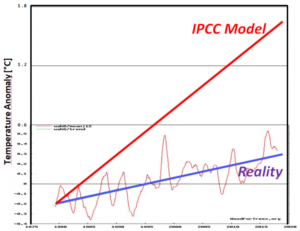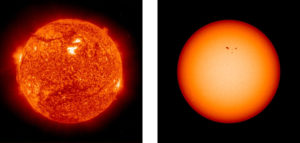by L. Ojha et al., July 20, 2018 in NatureCommunications (open access)
Transport of fine-grained dust is one of the most widespread sedimentary processes occurring on Mars today. In the present climate, eolian abrasion and deflation of rocks are likely the most pervasive and active dust-forming mechanism. Martian dust is globally enriched in S and Cl and has a distinct mean S:Cl ratio. Here we identify a potential source region for Martian dust based on analysis of elemental abundance data …
by Fundação de Amparo à Pesquisa do Estado de São Paulo, July 24, 2018 in ScienceDaily
A new study published in Geophysical Research Journal shows that the so-called Little Ice Age — a period stretching from 1500 to 1850 in which mean temperatures in the northern hemisphere were considerably lower than at present — exerted effects on the climate of South America.
Based on an analysis of speleothems (cave formations) in the Brazilian states of Mato Grosso do Sul and Goiás, the study revealed that in the seventeenth and eighteenth centuries, the climate of southwestern Brazil was wetter than it is now, for example, while that of the country’s Northeast region was drier.
The same Brazilian cave records showed that the climate was drier in Brazil between 900 and 1100, during a period known as the Medieval Climate Anomaly (MCA), when the northern hemisphere’s climate was warmer than it is now.
…
by Nils-Axel Mörner, November 13, 2017 in WUWT
These are the facts
- Sea level has remained virtually at the present level over the last 200 years
- In the last 50-70 years sea level has remained perfectly stable in Fiji
- This stability is indicated by the growth of corals (stopped to grow vertically, and forced to grow laterally into microatolls) – and corals do not lie
We have (with references at the end)
o Studied your tide gauge records – Mörner & Matlack-Kelin, 2017a
o Studied sites of coastal erosion – Mörner & Matlack-Klein, 2017b
o Documented sea level change during the last 500 years in great details –
Mörner & Matlakc.Kelin, 2917c
o Noted the close similarity to similar records in nations like the Maldives,
Bangladesh and India – Mörner, 2017
o We have presented our data at conferences in Rome (4th WCCC, October 19-21, 2017) and Düsseldorf (11th EIKE, November 9-10, 2017) – see: Clutz, 2017 and Tallbloke’s Talkshop, 2017)
…
by A. Watts, July 23, 2018 in WUWT and NatureCommunications
From the University of Helsinki and the “no SUV’s needed” department comes this study which suggests big cold snaps occurred right in the middle of the warm Eemian period. My only concern is perhaps they over-rely on climate models. For reference (and not part of the study) here’s the Eemian graph in context. Data sources listed int he graph.
…

by P. Gosselin, July 18, 2018 in NoTricksZone
No matter how hard climate-catastrophe obsessed alarmists attempt to beat out a little doom from the data, their results still fall far way short of their projections. Moreover, the modest warming the planet has seen over the recent decades is tied more to natural cycles.

Chart: P Gosselin, using WoodForTrees data.
by P. Gosselin, July 17, 2018 in NoTricksZone
The upcoming 6th IPCC Sixth Assessment Report will be a “comprehensive assessment of the science” related to climate change and published in 2022. However, don’t expect it to be “comprehensive” at all as hundreds of scientific publications showing profound impacts by sun and oceans will go ignored.
Climate science has turned into a religion that centers on a single act of faith. Human CO2 is changing our climate.
In the past it was always understood that climate was impacted by a vast array of factors, such oceanic cycles, solar cycles, aerosols, cloud cover, etc. to name a few.
…

Images: NASA (public domain)
by Jo Nova, July 19, 2018 in JoNova
Remarkably, some Japanese families kept weather record diaries in the 1700 and 1800s, and some for as long as 150 years. The connections they reveal are tantalizing but so incomplete. We are trying to fish out primitive signals from murky water. The Sun turns around on itself every 27 days, so these researchers are looking for repeating patterns in lightning that fit, but the poles of the sun spin slower than the equator and the sun spots can take their own time. Hence, it’s not a neat “27″ days.
During periods of high solar activity, they found regular peaks in lightning activity with the right timing, from May to September when the cold Siberian air mass is not so influential.
Other studies we’ve discussed here have investigated long solar cycles on the 11 year or 200 year scales ….
by P. Homewood, July 22, 2018 in NotaLotofPeopleKnowThat
Last week, the BBC seriously misled the public about so-called “heat records”, as I noted in this post here.
In particular the BBC made a song and dance about Southern California, even though the LA records were seriously compromised by siting in car parks or next to air conditioning exhaust vents.
But how does the recent Californian heatwave really compare with historical weather?
Fairmont is a rural USHCN station, just 110 km north of LA, and with a long term record dating back to 1922. (There is some data going back to 1909 as well):
(…)
La géologie, une science plus que passionnante … et diverse



